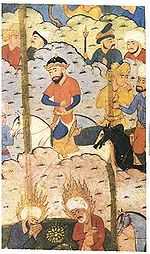Badi' al-Zaman al-Hamadani


Badi' al-Zamān al-Hamadāni or al-Hamadhāni (Arabic: بديع الزمان الهمذاني; 969 CE - 1007 CE) was a Medieval Arab[1] man of letters born in Hamadan, Iran. He is best known for his work the Maqamat, a collection of 52 episodic stories of a rogue, Abu al-Fath al-Iskandari, as recounted by a narrator, 'Isa b. Hisham. He was also known as "Badi uz-Zaman" (the wonder of the age).
Hamadani was born and educated in Hamedan, Iran. In 990 he went to Gorgan, where he remained two years; then passing to Nishapur, where he rivalled and surpassed the learned Khwarizmi. After journeying through Khorasan and Sistan, he finally settled in Herat under the protection of the vizir of Mahmud, the Ghaznevid sultan. There he died at the age of forty. He was renowned for a remarkable memory and for fluency of speech, as well as for the purity of his language.
His letters were first published at Constantinople (1881), and with commentary at Beirut (1890); his maqamas at Constantinople, and with commentary at Beirut (1889). A good idea of the latter may be obtained from Silvestre de Sacys edition of six of the maqamas with French translation and notes in his Chrestomathie arabe, vol. iii. (2nd ed., Paris, 1827). A specimen of the letters is translated into German in A. von Kremers Culturgeschichte des Orients, ii. 470 sqq.
See also
- Maqamat Badi' al-Zaman al-Hamadhani
- Arabic literature
References
References
External links
| Arabic Wikisource has original text related to this article: |
- The Maqámát of Badí‘ al-Zamán al-Hamadhání English translation at sacred-texts.com